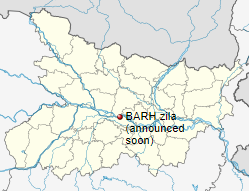Barh is a city in Patna district [[(39th proposed district) of Bihar. On 13th March 2022 ,in a general meeting at barh , chief minister Nitish Kumar announced that barh will be declared as a district soon. The district comes under Patna division of Bihar, India.,]] It is the oldest subdivision of India since British rule 1882. It is located on the southern bank of the Ganga River, a common place for Hindu cremation rituals. The place is well known for Umanath, a Shiva temple on the shores of the Ganga and the Alakhnath Temple. Laii, a sweet from Barh that looks like laddu, is known for its rich taste.
Demographics
According to the 2011 Census of India, Barh had a total population of 316,348 residents, with 162,354 males and 153,994 females. Barh has an average literacy rate of 100%.
Politics
Barh is a part of the Munger parliamentary constituency. It is also the oldest subdivision in India.
History
Barh has been a prominent trading satellite city in Patna, even in pre-Mughal and British periods.[according to whom?] It was an intermediary town between the river trade in Patna and Kolkata. Numerous references to Barh were found in travelogues by European visitors and historical chronicles of Islamic historians.[citation needed]
Peace Treaty of Barh
In 1495, after the sack of Patna, Sikandar Lodi advanced towards Bengal, but a non-aggression pact was made between the Delhi and the Bengal armies. It was decided that the territory to the east of Barh would be controlled by Bengal’s ruler, while those to the west would be controlled by the Delhi empire.
Sarai
During the Mughal period, Barh had a large sarai with 200 rooms for travelers/traders built by Sher Shah Suri.
Guru Tegh Bahadur’s visit
1666 Guru Tegh Bahadur stayed in Barh during his tour of the eastern districts in 1666 while on course to Assam at Bari Sangat situated in Chuna Khari Mohalla. The building was destroyed in 1934 earthquake, but an old well remains and priests belonging to Nanak Panthi Udasin Math continue to be in possession of open site.
A small gurdwara was established in Barh byTakht Harimandar Sahib for in Balipur Mohalla, Pipal Tal, near Tiraha Chowk for native Sikhs.
Mir Qasim
The British took gradual control of Bihar after the Battle of Plassey (1757). Mir Qasim (son-in-law of Mir Jafar who had betrayed Siraj ud-Daulah during the Battle of Plassey) executed the Jagat Seth before raiding Patna, which had been occupied by the British. He lost the Battle of Buxar, and Barh and Patna were taken into the British Empire.
Rennell’s Survey
In 1776, James Rennell, also called the “Father of Indian Geography”, surveyed Bengal and listed prominent destinations.
A zoomed view of Rennel’s 1776 Bengal map focussing on Barh (Bar) and nearby locations
A zoomed-in map of barh in 1812 as described in Buchanan travelogue
Barh Railway line
On 10 November 1877, the Barh railway station was opened to the public.
Plague
Between the 1890s to 1910, Barh and Patna were afflicted by the plague.
It is believed that the 1898 plague came by sea by rats aboard infected ships, though it first appeared in the British India Steam Navigation Company’s wharf. The two main factors for the spread of the plague were believed to be the high presence of rats and houses with poor hygiene and bad ventilation.
The population of the extended Barh subdivision decreased from 408,256 in 1891 to 365,327 in 1901 due to the plague.
Sati incident
In 1928, Sampati Kuer, a young widow from Berhna village, committed sati on the funeral pyre of her deceased husband. The British government suspected foul play and sentenced 10 people to prison, including her brother Murlidhar Pande, as sati was outlawed 100 years earlier by the British government.
Transport
Barh is by National Highway 31. The town also has a railway station with the same name.
NTPC Barh
Main article: Barh Super Thermal Power Station
NTPC Limited is India’s largest power-generating company. The former Prime Minister of India, Atal Bihari Vajpayee, laid the foundation stone of the main plant of stage 1 of NTPC Barh Super Thermal Power Station on 6 March 1999.



















